
The 2005-2006 FIA Proposals
Atlas F1 Technical Writer
Atlas F1's Craig Scarborough analyses the FIA's planned measures to reduce the speeds of Formula One cars as of next season. How will these measures impact the performance, and what can the teams do to work around the proposed limitataions?
In a press release on July 16th, the FIA said these measures "are likely to be imposed if satisfactory proposals have not been agreed by at least 8 teams and presented to the FIA before 6 September 2004."
The proposals themselves reveal the FIA plan to tackle three areas of the cars - with aerodynamics and tyres changed for 2005, and the engine moving towards 2.4 litre V8s for 2006.
This review will assess the impact of the regulations and propose some of the workarounds the teams are likely to adopt in order to meet the new challenges.
Diffuser height limited, front wing raised, rear wing element moved forward and changes to the bodywork immediately in front of the rear wheels. Together, these changes are estimated to reduce downforce on a current car by at least 25%, but reduce drag by less than 4%.
Explanation: lower downforce will reduce speeds, particularly in fast corners, and slightly increase braking distances, while the small reduction in drag will have a minimal effect on straight-line speeds.
Hence, wings can remain the same size but are moved to less efficient locations.The front wing will be raised, the rear wing brought forward and the diffuser cut down to a specific height. F1 cars will look very different as a result of these rules (see yellow areas on the graphic).
The cut down diffuser is the critical change. The current set up allows for a tall central tunnel, and probably this will be restricted to around half its height. The implications for this are of course reduced downforce, but how the teams will shape the revised diffuser will be a challenge.
With the preceding floor length almost written into the rules, current F1 cars have long flat floors (at both reference and step levels). In order to make these long floors work, an aggressive diffuser is needed to pull the air from under the floor. But in the FIA's plans, the diffuser cannot be as steep or tall, so the teams will either use long, low or shorter and steeper versions, placed at the extreme end of the car.
Furthermore, how the FIA will restrict the shaping of the lower wing mount and suspension from interacting and improving these tunnels has not been made clear.
Moreover, the wing now places its wake in closer proximity to the outboard obstacles, front wheels, brake ducts and the inboard obstacles, the chassis and the suspension. As the front wing change would be made in balance with the diffuser and rear wing change, the front to rear aero balance of the car should remain the same.
But, in order to return the cars to the previous levels of efficiency (downforce versus drag), some radical changes could be required. Raised nose will probably return, to give the wing space to work. Front brake ducts will need to be repositioned higher or lower to collect less disturbed air coming from the front wing. Front wing endplates will be very differently shaped, as they have the widest part of the wheel to direct their flow around.
Regaining the rear downforce will be the first problem. Losing the diffuser's contribution will be hard to regain, and instead the rear wing's contribution will need to be raised - which adds drag.
Lastly, the winglets and flip ups in front of the rear wheels are to be regulated. Presumably, this will be done by tightening dimensional regulation to limit the envelope where bodywork is allowed - possibly by adding a wedge shape exclusion zone ahead of the rear wheels, to prevent to the flip ups adopted across the grid. This change will have a small impact on downforce and drag, but it will require rethinking of cooling solutions as the use of chimneys may be excluded by these rules.
A driver may choose from two types of tyre, as in 2004. He will then have two sets of his chosen tyre, one for Friday and Saturday practice, the other for qualifying and the race. A damaged tyre can be replaced during the race (taken from the first set), but the car cannot be refuelled at the same time as the damaged tyre is changed.
Explanation: a tyre which must last 350 km rather than 80 km will have less grip, reducing cornering speeds, increasing braking distances and possibly producing less tyre debris or "marbles".
This is probably the most far reaching rule change proposed, and if adopted it would affect both the speed of the cars and the strategy the teams adopt in races.
Drivers will be challenged to safeguard the condition of their tyres, and excessive locked brakes, spins or hard use will degrade the tyres' performance and will affect the balance of their race. This should put some emphasis on careful drivers and their driving style.
The FIA put forward another benefit, which is the reduction in marbles from the harder tyres not shedding balls of rubber from the edge of the grooves. This will make the racing line a little wider, but regardless, the track off the racing line will still be dusty and not as rubbered as the main line, so little grip will be found off-line.
The decision not to allow refuelling while replacing a damaged tyre seems to be a double penalty, but it should prevent teams from trying to cheat the single set rule.
Regardless, in order to gain a good grid position (assuming refuelling is not allowed between qualifying and the race) will require low fuel load, so teams may opt to stop early in the race and then run a long middle stint on circuits where fuel load has a smaller effect on lap time. This will add further confusion to the spectators, who are unaware of the cars' fuel load, leaving them wondering why one driver is so slow or fast in a particular segment of the race.
One engine to last for two race weekends.
Explanation: both peak and average power will be less than for an engine with a shorter life.
This is a much anticipated rule change and for the manufacturers and spectators alike, it will offer little visible impact on the sport. The one engine per weekend rule has been adopted by the engine makers quite easily, with the occasional engine failure for the top teams providing some interest in the race as they regain grid positions.
Furthermore, the performance impact will be marginal, with the engines likely to maintain their RPM limit from this season, before increasing the RPMs through development steps during 2005.
The FIA has yet to explain how it will ensure engines are not serviced between races. Either tamper-proof labelling or a permanent FIA compound for engines are options. And what would the teams be allowed to retrieve from the engines (i.e. oil samples)? What could be changed? All these have yet to be clarified.
Finally, the penalty for changing an engine has not been revised, tempting some teams into replacing engines that are still serviceable but perhaps down on power compared to a new one at certain races. This was a fear when the rules changed prior to 2004, but this has yet to prove a problem in reality.
2.4 litre V8 (90°) with maximum bore diameter, fixed cylinder spacing, minimum crankshaft centre line height, minimum weight and minimum height of centre of gravity. Direct fuel injection, variable geometry inlet systems, variable geometry exhaust systems, variable valve timing and variable valve lift systems all prohibited. Only one spark plug, one coil and one injector per cylinder. Exotic materials banned.
Explanation: a 20% reduction in capacity will produce a corresponding drop in power. Constraints on design and the use of materials will significantly slow the rate of power increase and reduce the scope for using engine design to improve chassis characteristics. Keeping existing cylinder sizes retains many current engine components while keeping engine revs close to current levels.
Other engines
During 2006 and 2007, teams which cannot obtain a 2.4 litre engine will be able to use a 3 litre V10 with power restricted by means of a rev limit fixed by the FIA.
Explanation: this will ensure that all teams (including new entrants) have access to a competitive engine, even if supplies of the new 2.4 are initially restricted.
If the two race engine lifespan for 2005 was widely expected, so was a format change in capacity and cylinders.
The rules for the 2006 engines are very restrictive and perhaps will put off many manufacturers seeking F1 to demonstrate their technical skills. Engines will be fixed in format (90-degree V8) with fixed bore spacing - in itself limited to an unspecified maximum diameter. This, along with a host of bans on road car based technologies (i.e. variable valve timing) and new materials.
A V8 should prove lighter, shorter and the format presented is more balanced than a V10 so produces less vibration. These reductions should save weight around the rest of the car, which no longer has to transmit the load and vibrations.
Recouping the lost power will have to come from electronics, to control the power delivery, and ever higher revs to produce the peak power.
Higher revs require lighter engine internals with lower friction properties, so while the main material making the valve-train may be limited, the options for surface coatings will increase. One gain from a V8 engine is shorter cam shafts; the torsional stresses on the long V10 cam shafts have lead to many retirements even in 2004. Furthermore, the shorter burn time for the higher revolutions will also test the fuel companies.
Some teams will be able to run a 3.0l V10 for 2006 with limited revs, but any top teams choosing to do this would be controversial, so a much more stringent rev limit would be enforced by the FIA. Such are the changes to the chassis from running a 2.4l V8 that these teams will be a year behind in chassis design and probably will have to run heavier cars (or at least less ballast).
So what will a 2006 car look like?
This allows the chassis designers to include a smaller aerodynamic profile, with smaller radiators in smaller sidepods, which in turn are narrower at the rear, as the exhausts are tighter to the engine (only four pipes). The teams will need to make up for the lower weight limit with larger amounts of ballast under the front of the car.
The structures around the engine will be smaller, as less power and vibration will be transmitted - no doubt seven gears will be the norm as revs get higher and as power bands narrow and torque is reduced.
If tyres are not changed, then larger fuel tanks may be an option for longer stints, after a lightly fuelled qualifying run. Without larger tanks, a spacer somewhere along the car (between the engine gearbox) may be required to lengthen the wheelbase, pushing the rear wing back as far behind the roll structure as possible.
Last month, the FIA revealed a set of measures to reduce the speeds of F1 cars as of the 2005 season, after violent crashes in the Canadian and US Grand Prix convinced the president of the sport's governing body, Max Mosley, that today's F1 cars are becoming too fast and unsafe.
Aerodynamics (2005)
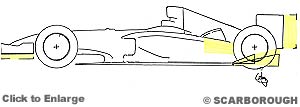 In the simplest terms, this plan will reduce downforce without reducing drag, and the combination will slow corner speeds and maintain straight-line speeds. In contrast, previous rule changes have reduced both downforce and drag, increasing straight-line speeds.
In the simplest terms, this plan will reduce downforce without reducing drag, and the combination will slow corner speeds and maintain straight-line speeds. In contrast, previous rule changes have reduced both downforce and drag, increasing straight-line speeds.
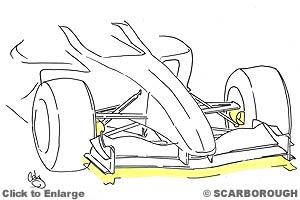 Front wing changes will also see the same dramatic effect as the 2001 changes. The whole wing will be raised, reducing the ground effect created between the wing and the ground and reducing the wings effectiveness (new wing position shown in graphic, old position in yellow).
Front wing changes will also see the same dramatic effect as the 2001 changes. The whole wing will be raised, reducing the ground effect created between the wing and the ground and reducing the wings effectiveness (new wing position shown in graphic, old position in yellow).
Tyres (2005)
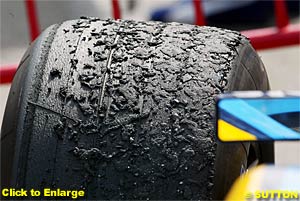 The lead time for Bridgestone and Michelin is incredibly short, so the amount of testing prior to the first race of 2005 will be huge, as the suppliers fight to get a solution. Michelin, with their broader range of motorsport experience, should have an advantage (for example, they will draw from their endurance racing experience, primarily Le Mans).
The lead time for Bridgestone and Michelin is incredibly short, so the amount of testing prior to the first race of 2005 will be huge, as the suppliers fight to get a solution. Michelin, with their broader range of motorsport experience, should have an advantage (for example, they will draw from their endurance racing experience, primarily Le Mans).
Engine (2005)
Engine (2006)
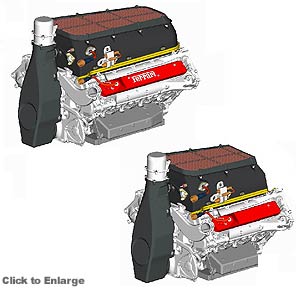 Current power figures are around 900-920 bhp, and the FIA expects a 20% drop in power to near 720bhp. Offsetting the power loss, with engines weighing around 90Kg now, will also be 20% shorter and lighter, raising the prospect of a 70Kg F1 engine (see comparison of a 2004 V10 engine and a comparable V8 in the foreground).
Current power figures are around 900-920 bhp, and the FIA expects a 20% drop in power to near 720bhp. Offsetting the power loss, with engines weighing around 90Kg now, will also be 20% shorter and lighter, raising the prospect of a 70Kg F1 engine (see comparison of a 2004 V10 engine and a comparable V8 in the foreground).
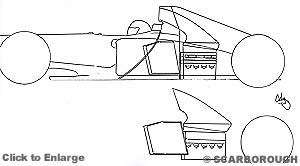 One factor offsetting the power losses will be the gains that the new engine will offer to the chassis. The engine will be shorter, lighter, less thirsty, produce less heat and less vibration, with the other gains of a slightly smaller inlet and exhaust system (see graphic with a V10 engine inset for comparison).
One factor offsetting the power losses will be the gains that the new engine will offer to the chassis. The engine will be shorter, lighter, less thirsty, produce less heat and less vibration, with the other gains of a slightly smaller inlet and exhaust system (see graphic with a V10 engine inset for comparison).
|
Contact the Author Contact the Editor |
Please Contact Us for permission to republish this or any other material from Atlas F1.
|
Volume 10, Issue 32
Articles
The Piranhas Bite Again
Technical Analysis: The FIA Proposals
Man in the Middle
Every Other Sunday
2004 Hungarian GP Preview
2004 Hungarian GP Preview
Hungarian GP Facts & Stats
Columns
The F1 Trivia Quiz
Rear View Mirror
Bookworm Critique
On the Road
Elsewhere in Racing
The Weekly Grapevine
> Homepage |